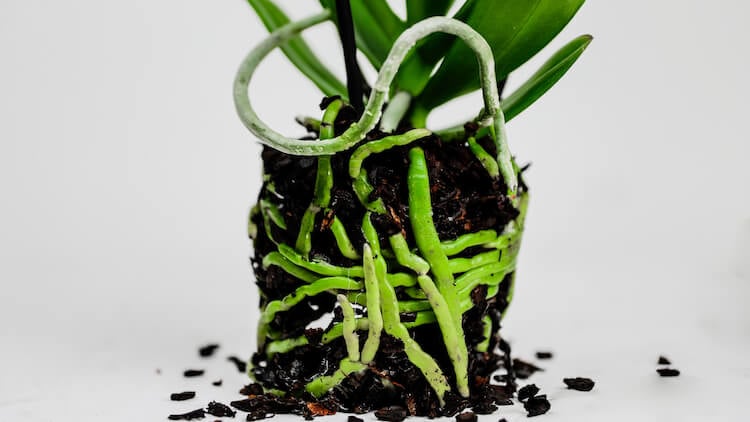
Want to keep your orchid plant healthy and strong? Focus on the roots! If they aren't healthy enough to do their job properly, they can't provide the necessary nutrients as the plant goes through its lifecycle. To be blunt, your orchid will starve and eventually die.
Since orchid roots behave differently than those of many other houseplants, this can be confusing to orchid plant parents.
Here’s a look at what your orchid’s roots may be telling you and what you need to do about it:
Since most orchid roots stay hidden within the orchid’s drainage pot, be sure to check the plant’s health by taking it out of its decorative pot so you can look through the clear growing container to see what's going on.
The Fix: Nothing! Vibrant green roots are a sign of excellent root health. Keep up the good work.
If your orchid's blooms have fallen but the roots are green, it has entered the vegetative or resting stage. You'll still need a good orchid care routine to make sure your plant stays healthy. This will also encourage future bloom growth.
The Fix: Roots that are silvery green or gray indicate your orchid is thirsty! Try soaking the roots in a sink of water for two minutes if your watering day is not due soon. Just make sure all the water is drained out of the plastic growing container before putting it back into its decorative pot. Orchids hate 'wet feet,' so if they sit in water for too long, their roots can get root rot!
Phalaenopsis Orchid roots can photosynthesize! This means that chlorophyll is present if the roots have any exposure to light. Completely white roots are lacking in chlorophyll, which means they were never exposed to light while growing and therefore didn't need to produce light-processing structures. The roots will not become white if they were once green!
At Just Add Ice, all of our orchids are grown in clear pots, thereby exposing them to light during their growth stage, and are only transferred to the decorative pots moments before shipping. This is why our orchids arrive with plump, green roots!
The Fix: This can be a sign of overwatering, which is the number one mistake indoor plant enthusiasts make.
Stop watering your orchid and wait for the roots to dry out. If the roots don’t dry out, wait until your orchid has finished blooming and trim any of the unhealthy roots with a sterile cutting tool, such as a pair of scissors. (Note: You can sterilize them with rubbing alcohol.)
To avoid this issue in the future, we recommend watering with ice. This way, you're giving it the exact amount of water it needs and, as the water melts, it provides the orchid water through a slow-drip method that decreases the chances of water standing at the bottom.
If you don't want to water with ice, you can use 1/4 cup of water for full-sized orchids.
The Fix: Instead of staying beneath the soil like most other roots, orchid roots twist and turn in all directions as they go in search of food, light and moisture, and may sometimes stick out of the pot as a result. 'Air roots' or 'aerial roots' are perfectly normal.
If the ends have become brown and mushy, trim off those unsightly bits with sterile scissors or a knife. To prevent infection, you can add cinnamon to the 'wound.'
While it’s normal for an orchid’s roots to appear above the potting media, you may want to choose a larger pot for your plant the next time you repot. Selecting a larger pot will give your orchid’s roots more room to comfortably grow and will prevent them from becoming root-bound, meaning the roots have run out of space.
If it looks like your orchid is outgrowing its pot, repot your plant as soon as it has finished blooming or the blooms have fallen off. Be sure the new pot has plenty of holes for drainage and that you only use potting media designed for orchids.
Healthy roots are at the root of good orchid health, so download our Orchid Root Health Guide to keep this information at your fingertips!


Copyright Just Add Ice® Orchids 2023